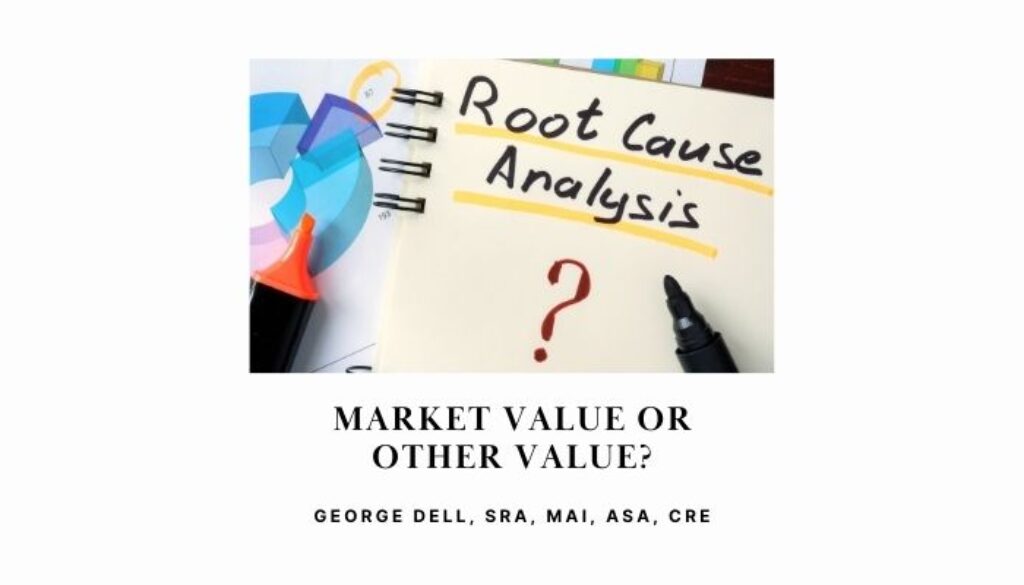Market value, of course! Or is it?
The great recession, and things like that, which come around every 12-15 years, all concur with the ‘accepted’ definition of market value, as written in the USPAP book Advisory Opinion 30. In short, the definition requires:
- Most probable price
- Competitive and open market
- Prudent and knowledgeable consumers
- No undue stimulus, with ‘typical’ motivation
- Well-advised, knowledgeable buyers and sellers
- “Reasonable” exposure time within an open market
- Cash, unaffected by special/creative financing/concessions
Please see the Dell “Operative Definition of Market Value,” which describes how, up to the “great recession,” five of the seven assumptions were ignored, in the standards-required “peer’s actions, user-expectations” groupthink culture.
There are other definitions:
- Value-in-use, for amenity properties, like homes, or non-residential business properties;
- Investment/speculative value for an income return, or future increased price
- Assessed value, for fairness in property taxes, (not expected sale price).
Other value types have one thing in common – they leave out, or ‘adjust’ one or more of the seven key parts of the agencies’ stated definition. Or artificially deviate from market price.
Reparative value is requested by some advocacy groups. Reparations are a separate issue, but become part of this issue for lenders, agents, appraisers, and the regulators charged with fixing this particular challenge. Reparative value, as I understand it, is intended to compensate for the decades of discriminatory regulatory, cultural, and personal bias embedded in deed restrictions, red-lining, and conscious and unconscious loan-creation bias.
A popular recent anecdotal case claimed that the appraiser opinion was too low (below the alleged ‘true’ or ‘real’ value) – therefore a higher opinion would have enabled the owner to get a bigger loan. If reparative value is to be higher than market value in each case, then minorities would be enticed to borrow money in a higher-risk situation. (And in a market downturn or adverse personal event — more likely to lose their home.)
If, on the other hand, reparative value is to be below “true” market value (to enable more minorities to purchase a home) then new minority buyers would be excluded (due to the “too low” loan collateral value). The exclusion might come from two sources: 1) the lender would be less inclined to loan on that property due to the perceived greater risk from the lower reported collateral value. 2) The seller would decline to sell at the lower ‘reparation’ value.
Other “values” can be useful for other special purposes. Forcing appraisers or AVMs (Automated Valuation Models) to indicate below or above the market-set price – would fail — due to the actions of Adam Smith’s “Invisible Hand.” (A fundamental law of micro-economics.)
The focus on appraisers — as if they are the ones who set market prices, is bound to fail. Appraisers are not autocratic price-fixers! Worse yet, this focus on appraisers distracts and diminishes the hope to start from point of truth: Market price is set by buyers and sellers. Appraisers (and AVMs) are the measurers of market actions. Price fixing creates additional unintended consequences, which will later require even more regulations to fix regulations. Measurements of the market are the starting point, not the end-all fix!

March 15, 2023 @ 8:43 am
For expediency sale, the residential appraiser has omitted due diligence steps in the measurement of market value as defined. One can get by with this when the markets are rising. Not so much when they start to decline.
In soft or declining markets Verifying the Motivations, Terms, Concessions or Personal Property packed into the Sales Prices become a very important factor.
Appraisers who omit this step are open to lawsuits and/or complaints. There is no way to prove that ones Peers don’t do it. There is only the process and procedure as written in our text and referred to by USPAP, Or a written and signed SOW Agreement.
If we have a SOW Agreement with the client that it is OK to use two Sources of Data, and are not obligated to Verify the data as to the Motivations, Terms, Concessions or Personal Property packed into the Sales Prices; we are off the hook.
Absent an agreement or proof of what our Peers do, we are all open to liability on this issue. If one wants to know how much contingent liability they have, all they have to do is add up all of the appraised values in the past 3-years. The first time I did this, it scared me, I felt overwhelmed.
I did not learn to Verify market data until I had been appraising about6-years. What about You?
Perhaps we can do a webinar on Verification Techniques.